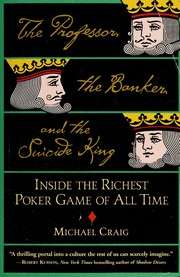The Professor, the Banker, and the Suicide King
 | |
| Author | Michael Craig |
|---|---|
| Country | United States |
| Language | English |
| Genre | Poker, Gambling |
| Publisher | Grand Central Publishing |
Publication date | 2005 |
| Pages | 282 pages (Paperback edition) |
| ISBN | 0-446-57769-3 (Paperback edition) |
| OCLC | 57316628 |
| 795.412 22 | |
| LC Class | GV1254 .C73 2005 |
The Professor, the Banker, and the Suicide King: Inside the Richest Poker Game of All Time ( ISBN 0-446-57769-3) is a 2005 book by Michael Craig detailing billionaire Andrew Beal's series of high-stakes poker games with Las Vegas' top professional poker players.[1] The book title refers to some of the professional players involved in this series. The Professor is mathematical poker mind Howard Lederer, the Banker is Andrew Beal himself, and the Suicide King is crazy, sometimes reckless player Ted Forrest. It also refers to the King of Hearts, since on the card the King's sword appears to be put in his head.[2][3]
Plot summary
The highest stakes poker match of all time were played over the course of a few years, between Andrew Beal and a group of professional poker players called "The Corporation."[4] The group included Ted Forrest, Jennifer Harman, Minh Ly, Doyle Brunson, Todd Brunson, Howard Lederer, David Grey, Chip Reese, Gus Hansen, Phil Ivey, Barry Greenstein, Lyle Berman and others. Many of them kept their identities anonymous, or were part of the group at different points.
Ted Forrest, a professional poker player, was driving outside of Las Vegas when he called the Bellagio poker room. The personnel in the poker room informed him the highest game is $10,000-$20,000 (which, at the time, was more than two times larger than any cash game ever played). He went to the poker room and sat down with his last $500,000. He played against Chip Reese and Andy Beal. Forrest had lost $400,000 without playing a single hand, and questioned why he was there.
Back in February 2001, Beal first visited the Bellagio poker room. He enjoyed the atmosphere and met professional poker players, like Todd Brunson. He ended up winning over $100,000 crediting it to luck. Beal decided to studied the game and face top players.
Andy returned to Las Vegas and played heads-up with professionals for the highest stakes. Top professional poker players decided to pool their money with everybody who they thought could play the game against Beal. Beal began his match with Chip Reese, then Ted Forrest sat down. (Forrest was unreachable, so he was not originally part of the group.) Down to his last $100,000 Forrest manages to make a comeback and wins $1.5 million. He is then asked to join the group and nobody else sits down besides Beal and his selected opponent, who alternates.
The matches continued for three years with the professionals winning most of their matches, but Beal occasionally coming out on top. In March 2004, Beal lost $16 million in two days, and vowed to quit poker.
Post 2004
For two years Beal keeps his vow to quit poker, but returns to high-stakes poker in 2006. These later matches were described online by Craig for Bluff Magazine.
Al Alvarez reviewed the book believing Andy Beal played for too long and Stu Ungar was connected to the Mafia.[5]
References
- ↑ Kaplan, Michael (29 June 2008). "Pro Poker Players Bet Away From the Table, Too". nytimes.com. Retrieved 2018-06-24.
- ↑ Burton, Eric (2005-07-05). "Learning About "The Professor, The Banker And The Suicide King"". PokerNews. Retrieved 2018-06-24.
- ↑ Kurson, Ken (2014-05-06). "EXCLUSIVE: A Player Speaks; Molly Bloom Takes On Spider-Man Actor in New Book". Observer. Retrieved 2018-06-24.
- ↑ Conneller, Philip (2015-03-17). "Pam Anderson Rick Salomon Divorce Battle Brings Alleged $40M Poker Win from Andy Beal to Light". Cardschat. Retrieved 2018-06-24.
- ↑ James, Murphy (2006-03-08). "Al Alvarez: The Poet Laureate of Poker". PokerNews. Retrieved 2018-06-24.
Further reading
- Michael Craig (17 June 2008). The Professor, the Banker, and the Suicide King: Inside the Richest Poker Game of All Time. Grand Central Publishing. ISBN 978-0-446-53963-0.